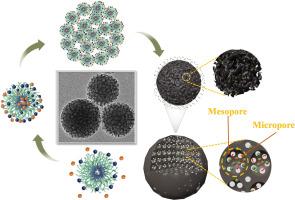一种新型多腔介孔结构碳微球的合成
IF 6.3
2区 环境科学与生态学
Q1 ENVIRONMENTAL SCIENCES
引用次数: 0
摘要
多孔碳微球由于其卓越的效率和可负担性而被广泛认为是一种优越的二氧化碳吸附剂。然而,多孔碳微球具有更好的吸附性能。而改变孔隙结构是有效的策略之一。本研究采用软硬模板协同法制备了多腔介孔碳微球,以热稳定性较好的酚醛树脂为碳前驱体,硅溶胶与F108的混合物为介孔模板。制备了具有多腔介孔结构的碳微球,所有样品的介孔高度均匀,直径在12 nm左右。随着二氧化硅溶胶用量的增加,APCF0.5-S1.75微球的直径从396.8 nm减小到182.5 nm左右,经CO2活化后,APCF0.5-S1.75微球具有较高的比表面积(983.3 m2/g),在0℃、1 bar条件下的CO2吸收率为4.93 mmol/g。这可能是由于其独特的多腔结构,提供了均匀的介孔通道,最小的CO2运输和更多的CO2吸附活性位点。本文章由计算机程序翻译,如有差异,请以英文原文为准。

Synthesis of a novel carbon microsphere with multi-cavity mesoporous structure for CO2 adsorption
Porous carbon microspheres are widely regarded as a superior CO2 adsorbent due to their exceptional efficiency and affordability. However, better adsorption performance is very attractive for porous carbon microspheres. And modification of the pore structure is one of the effective strategies. In this study, multi-cavity mesoporous carbon microspheres were successfully synthesized by the synergistic method of soft and hard templates, during which a phenolic resin with superior thermal stability was employed as the carbon precursor and a mixture of silica sol and F108 as the mesoporous template. Carbon microspheres with multi-cavity mesoporous structures were prepared, and all the samples showed highly even mesopores, with diameters around 12 nm. The diameter of these microspheres decreased from 396.8 nm to about 182.5 nm with the increase of silica sol. After CO2 activation, these novel carbon microspheres (APCF0.5-S1.75) demonstrated high specific surface area (983.3 m2/g) and remarkable CO2 uptake of 4.93 mmol/g at 0 °C and1 bar. This could be attributed to the unique multi-cavity structure, which offers uniform mesoporous pore channels, minimal CO2 transport of and a greater number of active sites for CO2 adsorption.
求助全文
通过发布文献求助,成功后即可免费获取论文全文。
去求助
来源期刊

Journal of Environmental Sciences-china
环境科学-环境科学
CiteScore
13.70
自引率
0.00%
发文量
6354
审稿时长
2.6 months
期刊介绍:
The Journal of Environmental Sciences is an international journal started in 1989. The journal is devoted to publish original, peer-reviewed research papers on main aspects of environmental sciences, such as environmental chemistry, environmental biology, ecology, geosciences and environmental physics. Appropriate subjects include basic and applied research on atmospheric, terrestrial and aquatic environments, pollution control and abatement technology, conservation of natural resources, environmental health and toxicology. Announcements of international environmental science meetings and other recent information are also included.
 求助内容:
求助内容: 应助结果提醒方式:
应助结果提醒方式:


